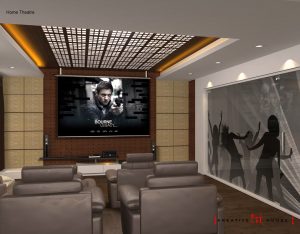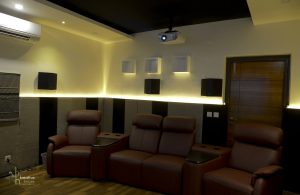TIPS ON DESIGNING A PERFECT HOME THEATER
A dedicated media room with high-tech audio and visual components is among the most desired amenities for Luxury homes. It creates a great place to watch television or movies and enjoy the program with minimal distractions. Since home theaters are specially designed to maximize the viewing experience, they allow you to enjoy all the benefits of an actual movie theater without leaving your home.

Creating the Theater Atmosphere
To create a theater atmosphere it is best to avoid rooms with a ton of natural light. This means no skylights and minimal windows. But if you plan to use the room for multipurpose, you may want to have the room with windows. In that case, consider installing blackout curtains to keep out the sun for daytime movie screenings while still giving you the option to open the windows
Similarly, lights with dimmers can be very beneficial as well. This type of lighting system can help ensure that the lights are not too bright as to cause a glare on the screen, but also light enough that no one will trip when moving about the room. Dimmers are a great tool for controlling the ambiance of the theater experience. And consider cove lighting at the top of the walls and wall sconces. Providing “layers” of dimmable lighting will give you total control of the “feel” of the room.
Sound Placement
The most important aspect of getting your home theater right is correct sound equipment placement. Surround sound speakers should be used, complete with a sub-woofer to really punch out the bass. Many home theater designers also find it beneficial to place padded fabric on the walls to help control reverberation (echoes) in the room. The walls, floor and ceiling should be sound-insulated to allow you to crank up the volume without disturbing others in the house. Products like fiberglass sound insulation, mass-loaded vinyl sheets behind the drywall, and extra-dense drywall, like Quiet Rock will help keep those dramatic theater sounds inside the room and not let them echo throughout the house.
Arrangement

The position of the seating area proportional to the viewing screen is critical to creating a perfect home theater experience. No one should be so far away from the screen where they feel they have to squint to see the screen and also that no one sits so close that they have to keep moving their heads to see the entire screen. Typically, the larger the screen the further back the seating should be. If the space in the home theater is limited, a smaller screen size will be better than a larger screen.
“There may be some instances where we simply cannot picture our perfect home theater. So, it is a good idea to contact a professional interior designer and see what ideas they may have about your available space.”

